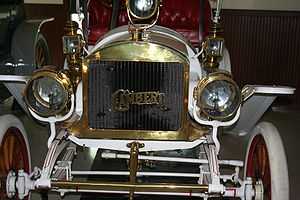Lambert Automobile Company
 | |
| Automobile Manufacturing | |
| Industry | Automotive |
| Founded | 1905 |
| Founder | John William Lambert |
| Defunct | 1916 |
| Headquarters | Anderson, Indiana, United States |
Area served | United States |
| Products |
Vehicles Automotive parts |

The Lambert Automobile Company was a 300,000-square-foot (28,000 m2) automobile factory in Anderson, Indiana to make the Lambert automobile through the Buckeye Manufacturing Company.[1]
History
The Lambert Automobile Company was initially the second factory plant for the Union Automobile Company of Union City, Ohio built in 1904. The name changed officially in 1905 to the Lambert Automobile Company and the Union Automobile Company name was dropped. A better quality automobile was then manufactured from the Union automobile.[2]
The Lambert Automobile Company was founded by automotive pioneer John William Lambert. The company was based in Anderson, Indiana. In the eleven years from 1905 through 1916 the company manufactured not only automobiles but trucks, fire engines and farm tractors as well. The Lambert automobile was the signature product of the company however. The company always made their own bodies, but sometimes had the engines manufactured by different independent motor builders. These outsourced motors done by manufacturers like Buda, Rutenber, Continental, Trebert, and Daviswere were always of Lambert's design. The upholstery used on the interiors was of the best quality and the final body finish was done with fifteen coats of paint.[3]
In 1906 Lambert produced the first "Lambert" automobile. With this line Lambert established himself as one of the more successful automobile manufacturers of that time period. Most of his automobiles were chain-driven rather than shaft driven. Production of automobiles and trucks had reached two thousand vehicles per year from 1906 to 1910. In 1910 the company had over a thousand employees and from 1910 to 1915 the production had reached about three thousand vehicles per year. It only produced about one thousand vehicles in 1916 and only a few vehicles in 1917.[2]
The Lambert Automobile Company manufactured the Lambert automobile through the Buckeye Manufacturing Company which had several subsidiaries.[4][5][6][7] One of the main features of the Lambert automobile was the friction gearing disk drive transmission. When the United States entered into World War I the factory was converted for national defense in 1917. The company then made ammunition shells, caisson wheels and military fire engines. When the war ended Lambert did not resume automobile production. He realized automobiles were only going to be made by large manufactures. The Buckeye Manufacturing Company stopped manufacturing automobile parts permanently in 1922.[3]
Additional
There are only four known Lambert automobiles in existence as of the year 2008. Ohio City, Ohio celebrates Lambert Days every summer.
It should also be noted that Union City, Indiana and Union City, Ohio are separated by a city street which is actually the Indiana-Ohio State Line. During the period of the Union Automobile Company (before ZIP Codes) all mail was received through an Indiana Post Office. Most advertisements and addresses for the Union Automobile Company will show their mailing address as Union City, Indiana.
George Lambert, brother of the famed John William Lambert, constructed the Lambert-Parent house. George sold it to his brother-in-law Wilder Grant Parent in 1898 - hence the name. The house is listed on the National Register of Historic Places and located at 631 E. Elm Street in Union City, Ohio. The Lambert brothers worked together in their businesses that was associated with automobiles, engines, and grain operations.[8]
See also
| Wikimedia Commons has media related to Lambert Automobile Company. |
- Union automobile
- Lambert automobile
- John William Lambert
- Buckeye gasoline buggy
- Union Automobile Company
- Buckeye Manufacturing Company
- Lambert Gas and Gasoline Engine Company
- Lambert friction gearing disk drive transmission
Notes
- ↑ G.N. Georgano, p. 1642
- ↑ 2.0 2.1 Dolnar, pp. 225–228
- ↑ 3.0 3.1 Kimes, p. 835
- ↑ The Horseless Age: The Automobile Trade Magazine, p. 127
- ↑ Anderson Morning Herald, June 24, 1904, p. 3; March 14, 1905, p. 8; March 21, 1905, p. 1; April 30, 1905, p. 2; May 10, 1905, p. 1; May 24, 1905, p. 1; June 16, 1909, p. 1; November 18, 1909, p. 8; Jan. 27, 1911, p. 8; March 11, 1911, p. 8
- ↑ Anderson Sunday Herald; Anderson, Indiana; November 16, 1958
- ↑ Brandon, p. 180
- ↑ Lambert-Parent House
Primary sources
- Biography of John W. Lambert, written by his son January 25, 1935 — obtained from the Detroit Public Library, National Automotive History Collection
- Dolnar, Hugh, Automobile Trade Journal, article: The Lambert, 1906 Line of Automobiles, Chilton Company, v.10 January 1906
- Forkner, John L., History of Madison County, Indiana, New York and Chicago, The Lewis Publishing Company, 1914
- The Horseless Age: The Automobile Trade Magazine, The Horseless Age Company, 1902
Secondary sources
- Bailey, L. Scott, Historic Discovery: 1891 Lambert, New Claim for America's First Car, Antique Automobile magazine, Vol. 24, No. 5, Oct–Nov 1960
- David Burgess Wise, The New Illustrated Encyclopedia of Automobiles ISBN 0-7858-1106-0
- Dittlinger, Esther et al., Anderson: A Pictorial History, G. Bradley Publishing, 1990, ISBN 0-943963-16-8
- G.N. Georgano, The Beaulieu Encyclopedia of the Automobile, Taylor & Francis, 2000, ISBN 1-57958-293-1
- Huffman, Wallace Spencer, Indiana's Place in Automobile History in Indiana History Bulletin, vol 44, no. 2, Feb. 1967; Indianapolis, Indiana Historical Bureau
- Huhti, Thomas, The Great Indiana Touring Book: 20 Spectacular Auto Tours, Big Earth Publishing, 2002, ISBN 1-931599-09-2
- James, Wanda, Driving from Japan, McFarland, 2005, ISBN 0-7864-1734-X
- Kimes, Beverly Rae, Standard Catalog of American Cars, 1805–1942, Krause Publications, 1996, ISBN 0-87341-428-4
- Madden, W. C., Haynes-Apperson and America's First Practical Automobile: A History, McFarland, 2003, ISBN 0-7864-1397-2
- Scharchburg, Richard P., Carriages Without Horses: J. Frank Duryea and the Birth of the American Automobile Industry, SAE, 1993, ISBN 1-56091-380-0